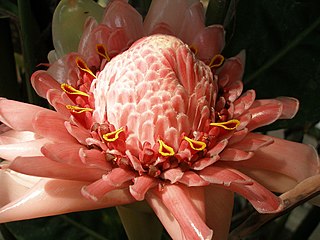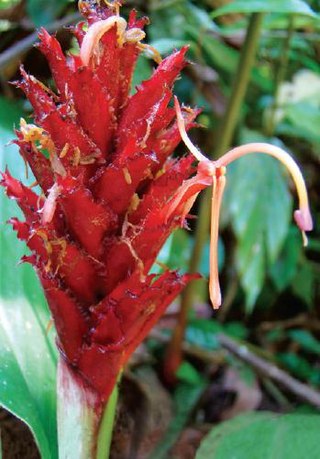
The Zingiberales are flowering plants forming one of four orders in the commelinids clade of monocots, together with its sister order, Commelinales. The order includes 68 genera and 2,600 species. Zingiberales are a unique though morphologically diverse order that has been widely recognised as such over a long period of time. They are usually large herbaceous plants with rhizomatous root systems and lacking an aerial stem except when flowering. Flowers are usually large and showy, and the stamens are often modified (staminodes) to also form colourful petal-like structures that attract pollinators.

Zingiberaceae or the ginger family is a family of flowering plants made up of about 50 genera with a total of about 1600 known species of aromatic perennial herbs with creeping horizontal or tuberous rhizomes distributed throughout tropical Africa, Asia, and the Americas. Many of the family's species are important ornamental, spice, or medicinal plants. Ornamental genera include the shell gingers (Alpinia), Siam or summer tulip, Globba, ginger lily (Hedychium), Kaempferia, torch-ginger Etlingera elatior, Renealmia, and ginger (Zingiber). Spices include ginger (Zingiber), galangal or Thai ginger, melegueta pepper, myoga, korarima, turmeric (Curcuma), and cardamom.

Ginger is a flowering plant whose rhizome, ginger root or ginger, is widely used as a spice and a folk medicine. It is a herbaceous perennial which grows annual pseudostems about one meter tall, bearing narrow leaf blades. The inflorescences bear flowers having pale yellow petals with purple edges, and arise directly from the rhizome on separate shoots.

Boesenbergia rotunda, commonly known as Chinese keys, fingerroot, lesser galangal or Chinese ginger, is a medicinal and culinary herb from China and Southeast Asia. In English, the root has traditionally been called fingerroot, because the shape of the rhizome resembles that of fingers growing out of a center piece.

Costaceae, known as the Costus family or spiral gingers, is a family of pantropical monocots. It belongs to the order Zingiberales, which contains horticulturally and economically important plants such as the banana (Musaceae), bird-of-paradise (Strelitziaceae), and edible ginger (Zingiberaceae). The seven genera in Costaceae together contain about 143 known species. They are native to tropical climates of Asia, Africa, Central America, and South America. Several species are frequently found in cultivation.

Etlingera elatior is a species of herbaceous perennial plant in the family Zingiberaceae; it is native to Indonesia, Thailand, Malaysia and New Guinea.

Costus is a genus of herbaceous perennial plants in the family Costaceae, erected by Linnaeus in 1753. It is widespread through tropical and subtropical regions of Asia, Africa, and the Americas.

Zingiber zerumbet is a species of plant in the ginger family with leafy stems growing to about 1.2 m (3.9 ft) tall. It originates from Asia, but can be found in many tropical countries. Common names include: awapuhi, bitter ginger, shampoo ginger, lempoyang and pinecone ginger.
Paulus Johannes Maria "Paul" Maas is a botanist from the Netherlands and a specialist in the flora of the neotropics. Maas has identified and named about two hundred fifty plants from the Burmanniaceae, the Costus Family (Costaceae), the Gentian Family (Gentianaceae), the Bloodwort Family (Haemodoraceae), the Banana Family (Musaceae), the Olacaceae, the Triuridaceae, and the Ginger Family (Zingiberaceae).

Alpinia caerulea, commonly known as native ginger or Australian ginger, is an understorey perennial herb in the family Zingiberaceae which grows in rainforest, gallery forest and wet sclerophyll forest in eastern Australia.

Cautleya is a small genus of perennial plants of the family Zingiberaceae, found in the eastern Himalayas through to China and Vietnam. It consists of two species of high-altitude tropical and temperate plants, native to cool forest areas – an unusual habitat for members of the Zingiberaceae. They are grown as ornamental flowering plants.

Curcuma angustifolia is one of over 80 species belonging to the genus Curcuma, in the family Zingiberaceae. This species is native to the Indian subcontinent and is more commonly known as East Indian arrowroot or narrow-leaved turmeric in English, and is called "yaipan" in Manipuri, "Aipah" in Thadou-Kuki, "tikhur" in Hindi, and "Koova" കൂവ in Malayalam/Tamil, and is called "Kutupah" in Poula. In the Eastern hemisphere, the plant plays an integral role in many cultures.

Zingiber spectabile is a species of true ginger, native to Maritime Southeast Asia. It is primarily grown in the West as an ornamental plant, although it has been used in South-East Asia as a medicinal herb.

Zingiber barbatum is a medicinal, therapeutic ginger found in Myanmar. The plant, a rhizome geophyte, is concentrated primarily in the Yangon, Bago, and Mandalay regions, although specimens have been found in at least two other administrative regions.

Costus spectabilis, commonly known as the yellow trumpet, is an African, gregarious species of herb; low and perennial, it is found from Sierra Leone to Sudan to as far south as Angola and Zimbabwe.

Larsenianthus is a genus of monocotyledonous plants in the ginger family (Zingiberaceae). The genus was established in 2010. The four or so species are native to the area of the eastern Himalayas.
Larsenianthus arunachalensis is a species of the genus Larsenianthus in the ginger family (Zingiberaceae).. It was first described in 2010 and is native to northeastern India, and Myanmar.
Newmania is a genus of rhizomatous based flowering plants belonging to the family Zingiberaceae. They are only native to Vietnam, and found in forests.

Costus woodsonii, the red button ginger or scarlet spiral flag, is a species of flowering plant in the family Costaceae, native to Nicaragua, Costa Rica, Panama, and Colombia. A rhizomatous geophytic perennial, it is recommended for coastal gardens, borders, containers, and general wet, tropical garden applications. It is more widely cultivated than other species of Costus. Costus woodsonii is named for Robert Woodson of the Missouri Botanical Garden.

Costus productus, known as orange tulip ginger, dwarf orange ginger, or green mountain spiral flag, is a species of plant in the Costaceae family. Costus productus is native to South Colombia and Peru.

















